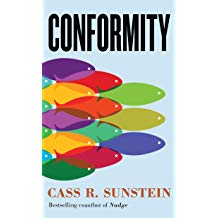Encourage Dissent
By Arnold Kling


- Much of the time, it is in the interest of the individual to follow the crowd but in the social interest for individuals to say and do what they think best. Well-functioning institutions take steps to discourage conformity and to promote dissent, partly to protect the rights of dissenters but mostly to protect interests of their own.
- —Cass Sunstein, Conformity: The Power of Social Influences1
According to Cass Sunstein, our beliefs and decisions can be adversely affected by groupthink. Individuals with different points of view have an incentive to suppress their voices. To correct for this tendency, we need to adopt social norms and formal institutions that encourage people with private doubts about conventional wisdom to speak out.
Sunstein argues that there are two basic reasons why we tend to modify our beliefs to conform to those of others.
- First, the actions and statements of other people provide information about what is true and what is right… You might well take their beliefs as evidence of what you should believe.
- Second, the actions and statements of other people tell you what you ought to do and say if you want to remain in their good graces (or get there in the first place). Even if you disagree with them in your heart of hearts, you might silence yourself or even agree with them in their presence. Once you do that, you might find yourself starting to shift internally. You might begin to act and even think as they do.
It is impossible for human beings to obtain all of our knowledge through our own observations and insights. Instead, we are adept at learning from one another.2 Sunstein writes,
- Most of what we think—about facts, morality, and law—is a product not of firsthand knowledge but of what we learn from what others do and think. This is true even though they too may be merely following the crowd.
Sunstein cites the classic experiments of Solomon Asch on conformity. The individual subject would be placed in a room with three other people who, unknown to the subject, were confederates of the experimenter. The individuals would be shown three lines of different lengths and asked which line most closely matches in length the line on a card. The confederates would all choose an incorrect answer. The question was whether the experimental subjects would choose the correct answer or go along with the confederates.
- Asch’s findings contain two conflicting lessons. First, a significant number of people are independent much of the time… such people are not influenced by the group… Second, most subjects, at least some of the time, are willing to yield to the group even on an apparently easy question in which they have direct unambiguous evidence.
Subsequent experiments involving conformity show that if subjects are rewarded for group success rather than for their own individual success, they will more readily voice dissent. The reason, Sunstein argues, is that when you are rewarded for your success as an individual, you think that going with the group consensus increases your chance of earning the reward in case you are mistaken. But when you know that group success will be rewarded, you know that you can make an individual mistake without necessarily costing your group the reward.
Sunstein argues that when a group of like-minded individuals gets together, they tend to move toward extreme positions.
- When like-minded people talk to one another, they usually end up thinking a more extreme version of what they thought before they started to talk.
What happens in such a group is that any initial doubts that you had about your position are erased as you listen to others who share your outlook. In other words, if you are a Democrat, and you join a conversation among other Democrats, you are likely to become more convinced that Democrats are the good party and Republicans are the bad party. Your initial views have been reinforced by the group.
Sunstein goes on to note that
- group polarization can be fortified because of “exit,” as members leave the group because they reject the direction in which things are heading. If exit is pervasive, the tendency to extremism can be greatly aggravated. The group will end up smaller, but its members will be both more like-minded and more willing to take extreme positions.
Moreover,
- Society might well become fragmented as a result of “iterated polarization games,” in which groups of like-minded people—initially different, but not terribly different, from one another—drive their members toward increasingly diverse positions. Many nations are now seeing such iterated polarization games (sometimes spurred by social media), and they make governance far more difficult.
How can we use our knowledge of the process of conformity to design mechanisms to prevent its bad effects? Sunstein argues that
- the institutions of the U.S. Constitution reflect a fear of conformity, cascade effects, and group polarization. To combat the risks, the document creates a range of checks on ill-considered judgments
Dividing government into three branches and further dividing government powers through federalism served to limit the effect of groupthink. Freedom of speech and freedom of the press also serve this purpose. Informal norms, such as the Senate filibuster, empower dissenters.
Sometimes, a consensus is broad but shallow. In such instances, one mild dissenter can lead others to raise concerns with the consensus position.
One tool that Sunstein does not mention but which I have seen organizations use, is a “5-3-1” signaling system. When a consensus appears to be reached at a meeting in favor of a particular proposal, the chairperson asks everyone to hold up one, three, or five fingers. Five fingers means that you could champion the proposal, because it reflects your private beliefs. Three fingers means that you have some private doubts about the proposal, but you can accept it. One finger means that you privately object to the proposal.
When people raise their hands, the chairperson subsequently calls on everyone who raised either one or three fingers to articulate their doubts. Often, others in the meeting find that they can sympathize with the doubts, and the group will rework its proposal in order to meet the potential objections. But if the 5-3-1 system had not been used, the dissenters might never have been given encouragement to voice their concerns.
Unfortunately, it seems to me that in at least some arenas, we are discouraging rather than encouraging dissent. In social media, and also in broadcast media, I see a lot of attempts to stoke the outrage of people who already agree with the viewpoint of the commenter.
On college campuses, “call-out culture” encourages mob suppression of unpopular views. This culture appears to be spreading beyond the campus. I wish that Sunstein had addressed this issue and offered suggestions about what might be done to overcome it.
It seems to me that Americans are becoming increasingly uncomfortable with viewpoints that diverge from their own. Sunstein’s book shows why such a trend is unhealthy. I wish that we knew more about how to reverse the trend.
Footnotes
[1] Cass Sunstein. Conformity: The Power of Social Influences. NYU Press, May 2019.
[2] See “The Social Learning Animal,” by Arnold Kling. Library of Economics and Liberty, June 5, 2017.
*Arnold Kling has a Ph.D. in economics from the Massachusetts Institute of Technology. He is the author of several books, including Crisis of Abundance: Rethinking How We Pay for Health Care; Invisible Wealth: The Hidden Story of How Markets Work; Unchecked and Unbalanced: How the Discrepancy Between Knowledge and Power Caused the Financial Crisis and Threatens Democracy; and Specialization and Trade: A Re-introduction to Economics. He contributed to EconLog from January 2003 through August 2012.
Read more of what Arnold Kling’s been reading. For more book reviews and articles by Arnold Kling, see the Archive.
